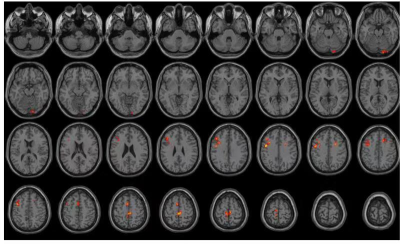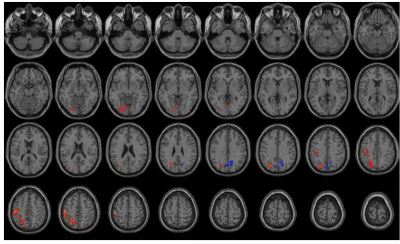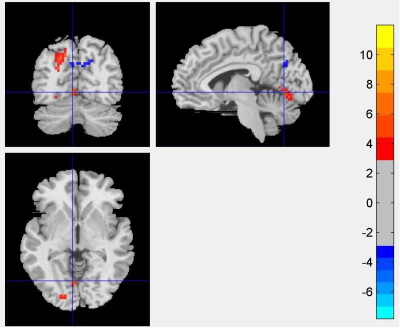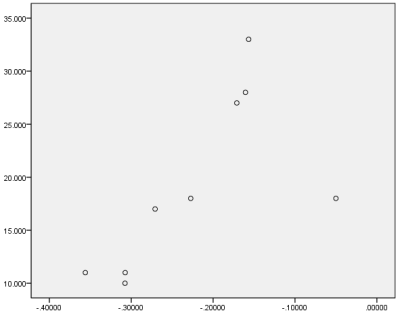3987
Resting State Functional Magnetic Resonance Imaging Study of Auricular Electro-acupuncture Therapy on Treatment-Resistant Depression
KE XU1, JILIANG FANG1, and XIAOJIAO LI1
1CHINA ACADEMY OF CHINESE MEDICAL SCIENCES, BEIJING, China
1CHINA ACADEMY OF CHINESE MEDICAL SCIENCES, BEIJING, China
Synopsis
The aim of this study was to provide scientific basis for the therapeutic mechanism of auricular electro-acupuncture in treatment resistant depression patients. We evaluated the resting state functional connectivity before and after 8 week .Results showed that functional connectivity increased in the lingual gyrus and precuneus ,which is related to default mode network (DMN), might playing a potential part for the significant improvement of clinical symptoms in TRD patients.
INTRODUCTION
Depression is a type of mental illness with high prevalence characteristiced by emotional, cognitional, and neurological disorder. Most patients with depression can be relieved or cured by antidepressants while some patients remained non-reactional, namely, treatment-resistant depression (TRD).TRD has the worst impact on the recovery of patients' social functions, and leads to the division of personality , resulting in heavy burdens to both families and society .PURPOSE
Auricular electro-acupuncture has been proved to be an effective method for the treatment of depression, but its mechanism has yet not been clarified. This study was designed to investigate the changes of resting state functional network connectivity (rs-FC) before and after 8 week period of treatment-resistant depression (TRD),to analyze the correlation between clinical effect and the changes in rsFC after 8 weeks in TRD groups, so as to provide scientific basis for the therapeutic mechanism of auricular electro-acupuncture in the treatment of TRD patients.METHODS
This study enrolled 12 patients with TRD while the transcutaneous auricular vagus nerve stimulation(Huatuo brand,SDZ-IIB)were used to stimulate bilateral ear concha, and the original basic drug treatment remained unchanged.Data were collected on a MAGNETOM Skyra 3T MR scanner (Siemens Healthcare, Erlangen, Germany) with a 20-channel head coil. Firstly high-resolution T1-weighted was acquired for each participant, using the following parameters: Echo time (TE) =2.98ms, repetition time (TR) =2.53 s, visual field =256×256 mm, FOV= 256 mm, voxel size =1×1×1 m³, Flip angle =7°, slice thickness = 1.00 mm, resolution =1×1. Then BOLD functional imaging was obtained using a T2-weighted gradient-echo EPI sequence with the parameters: TR =2000 ms, TE =30 ms, visual field = 70×70 mm, FOV 224mm, flip angle = 90°, resolution 3×3, voxel size =3×3×3mm³ , slice thickness = 3.5 mm. 6 min and 3 seconds , 6 min and 46 seconds for each run respectively. In week 0 and week 8,17-item Hamilton Depression Scale(HAMD-17)was observed and resting state fMRI data was collected using blood oxygen level-dependent functional magnetic resonance imaging (BOLD-fMRI)technique . The bilateral rACC were selected as the seed regions given its central role in emotional and cognitive processing. The left and right rACC were defined with the central coordinates(-4, 37, 0; 4, 37, 0)and in a radius of 3 mm of the seed regions and computed their correlations with the rest of the whole brain. Using SPSS 20.0 statistical software, the paired t-test was used to analyze the changes of rs-FC in TRD group after 8 weeks of treatment. Spearman coefficient analysis was used to analyze the correlation between changes HAMD-17 and rs-FC in TRD . Differences in rsFC before and after treatment beyond a given threshold level(0.5)cluster size(100 voxels)were considered to have a significant change.RESULTS
Due to the change of fMRI parameters , 3 cases of inconsistent data were removed, 9 cases of complete data were obtained.The symptoms of most patients were alleviated gradually after 8 weeks of treatment.The scores of HAMD were significantly decreased (P < 0.001). The average reduction rate of HAMD scores were 43.77%, 61.74% and 74.83%, respectively. 9 subjects reached clinical recovery, 8 subjects’ symptoms showed improved significantly, 2 subjects were improved, and 1 subject was ineffective. The response rates is 94.1%. FC increased between the right rACC and a set of regions including the left precuneus , left postcentral, left lingual gyrus,left precuneus and left postcentral; FC decreased between the left rACC and the right precuneus.After 8 weeks of treatment, there was a significant positive correlation between FC enhancement and HAMD-17 difference in the left lingual gyrus of the left rACC.CONCLUSION
Auricular electro-acupuncture has a synergistic effect on TRD.After 8 weeks of auricular electro-acupuncture treatment, FC increased in rACC-precuneus/postcentral/lingual gyrus, especially in the lingual gyrus and precuneus in TRD patients.The modulation effect is related to default mode network (DMN), which might be an important mechanism for the significant improvement of depressive symptoms in TRD patients.Acknowledgements
No acknowledgements found.References
[1] Otte C, Gold S M, Penninx B W, et al. Major depressive disorder. Nat Rev Dis Primers, 2016, 2: 16065.[2]Fang J,Egorova N,Rong P,et al. Early cortical biomarkers of longitudinal transcutaneous vagus nerve stimulation treatment success in depression[J]. Neuroimage Clin,2017,14(C):105-111.Figures

Brain activity regions which are differed from right rACC in the rs-FC changes after 8 weeks in TRD patients.

Brain activity regions which are differed from left rACC in the rs-FC changes after 8 weeks in TRD patients.

FC increased between the left rACC and left lingual gyrus.

The correlation between reduction of HAMD-17 score and the change of FC.